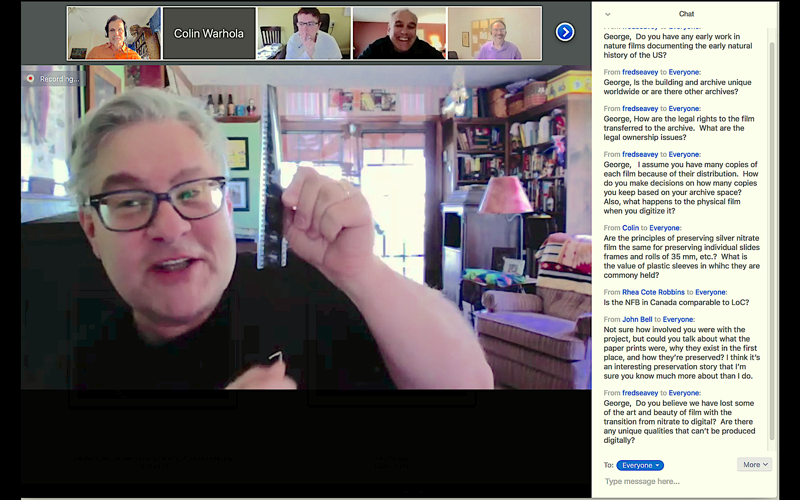
00:00 Introduction by Jon Ippolito
01:19 How George came to manage the nitrate film archive
04:25 Facts about the collection
05:02 The Culpeper complex (and the zombie apocalypse)
10:08 Vault conditions and discovery tools
12:24 Importance of a human archivist
14:02 Deterioration of nitrate films
16:10 Nitrate: an explosive medium
21:30 Safety (acetone) film isn't safe
25:28 What can you do about decaying formats?
27:02 Fred Seavey: what are the LoC's holdings of nature and educational films?
30:10 Other national film archives
30:50 Georges Melies and the beauty of reprinted negatives
32:53 Legal rights and preservation
35:10 What copies should be saved for preservation?
36:35 Preserving film versus slide frames
38:07 How you get a print or copy from a negative?
39:51 What is lost and gained in going from film to digital?
41:29 Unique qualities that can’t be reproduced digitally
43:26 Process for digitizing film
44:35 Rhea Cote Robbins: How do US and Canadian film archives compare?
45:02 "Frozen Time": documentary on deteriorated nitrate by Bill Morrison
46:27 John Bell on paper prints
51:35 Should old formats be discarded upon digitization?
52:20 Fred Seavey: initiatives for preserving home movies?
53:44 Mystery film of JFK's assassination
54:20 LoC's recommended digitization formats
56:50 Storage of digital formats
57:35 Magnetic tapes versus hard drives
58:10 Proportion of collection digitized
58:34 Offsite backup versus cloud
59:41 Colin Windhorst: how hard is adjusting to the transition to digital?
This teleconference is a project of the University of Maine's Digital Curation program. For more information, contact ude.eniam@otiloppij.
Timecodes are in Minutes: hours
In this teleconference, we get up close and personal with the Library of Congress's film manager George Willeman, who oversees a vast archive of audiovisual culture stretching over 100 years. Willeman's job ranges from preserving Thomas Edison's earliest films from 1891 to migrating stock to the latest digital formats.

Willeman's vault at the library of Congress contains 90 miles of shelving for analog film and video as well as petabytes of digital storage. The heavily fortified building also has a fascinating history as a cold war relic. It was built to house 300 members of the US government in case a nuclear war wiped out nearby Washington. His work is profiled in Wired and a Gravitas documentary.
Although the focus was storing and digitizing film, the conversation ranged from preserving Hollywood classics to home movies, and why the most volatile medium for film might be best for its long-term storage. Despite his busy schedule, Willeman was willing to meet from his home, where his boisterous son James makes a cameo appearance.
Watch the entire video or choose an excerpt from the menu on this page.
Or view more teleconferences from the Digital Curation program.